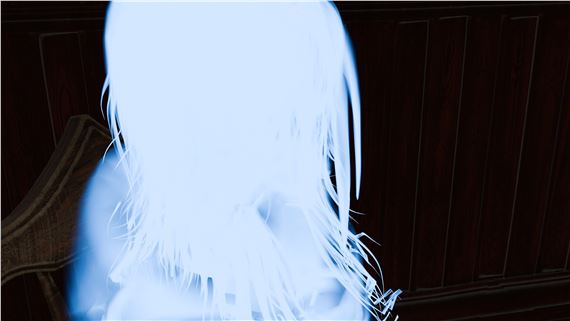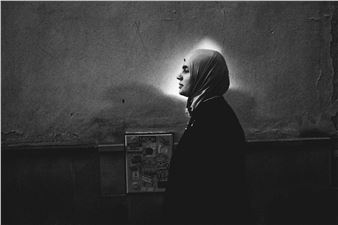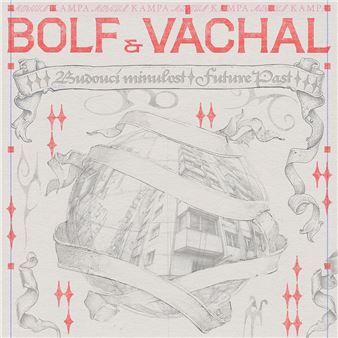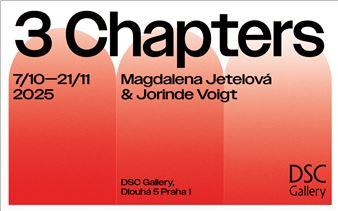home is where the haunt is
The question “If you were a ghost, where would you like to haunt?” features in the film Recital Hall by the Dutch-French duo Megan Bruinen and Elouan Le Bars. It immediately transports viewers into the abandoned spaces of a virtual palace, where silence mingles with echoes of the past. These rooms might well be filled with the melancholic songs of another exhibiting artist, German writer and performer Olga Hohmann. Her vocal compositions offer a sense of familiarity and comfort, yet at the same time evoke a creeping uncertainty — nostalgia for something lost, strangely familiar, and no longer there. In his now-iconic concept of hauntology, cultural theorist and philosopher Mark Fisher reminds us that the word haunt refers not only to a place of dwelling, but also to that which penetrates and disrupts it. This very ambiguity becomes central to the atmosphere of the exhibition.
Four years after her last solo show at Kvalitář, Antonie Stanová returns with home is where the haunt is, revisiting her earlier figurative works and her personal archive of drawings and motifs. This time, the nature of her paintings engages more directly with memory — its rearrangement and distortion, shaped by the passage of time as well as the physical and mental states of its bearers. Drawing, with its immediacy and speed, allows for a freer, more intuitive flow through space. The delicacy of charcoal enhances the dreamlike quality of the narrative, where past, present, and future planes intersect. The collage-like structure of her canvases, stitched together from individual fragments, disrupts linear time and opens up an experience akin to wandering through virtual spaces. In such spaces, the absence of fixed boundaries makes possible new ways of forming memory and recollection. Traces of the past — voice and text messages, undelivered images, deleted chats, or shared locations — gradually lose their anchoring. They can be rearranged, overlaid, erased, or layered anew. This interplay of emptiness and form allows painting to function much like the digital realm: distorting, bending, and recycling visual and textual records while reviving the ghosts of the past.

Recommended for you
The question “If you were a ghost, where would you like to haunt?” features in the film Recital Hall by the Dutch-French duo Megan Bruinen and Elouan Le Bars. It immediately transports viewers into the abandoned spaces of a virtual palace, where silence mingles with echoes of the past. These rooms might well be filled with the melancholic songs of another exhibiting artist, German writer and performer Olga Hohmann. Her vocal compositions offer a sense of familiarity and comfort, yet at the same time evoke a creeping uncertainty — nostalgia for something lost, strangely familiar, and no longer there. In his now-iconic concept of hauntology, cultural theorist and philosopher Mark Fisher reminds us that the word haunt refers not only to a place of dwelling, but also to that which penetrates and disrupts it. This very ambiguity becomes central to the atmosphere of the exhibition.
Four years after her last solo show at Kvalitář, Antonie Stanová returns with home is where the haunt is, revisiting her earlier figurative works and her personal archive of drawings and motifs. This time, the nature of her paintings engages more directly with memory — its rearrangement and distortion, shaped by the passage of time as well as the physical and mental states of its bearers. Drawing, with its immediacy and speed, allows for a freer, more intuitive flow through space. The delicacy of charcoal enhances the dreamlike quality of the narrative, where past, present, and future planes intersect. The collage-like structure of her canvases, stitched together from individual fragments, disrupts linear time and opens up an experience akin to wandering through virtual spaces. In such spaces, the absence of fixed boundaries makes possible new ways of forming memory and recollection. Traces of the past — voice and text messages, undelivered images, deleted chats, or shared locations — gradually lose their anchoring. They can be rearranged, overlaid, erased, or layered anew. This interplay of emptiness and form allows painting to function much like the digital realm: distorting, bending, and recycling visual and textual records while reviving the ghosts of the past.
Artists on show
Contact details


 ARTISTS
ARTISTS











